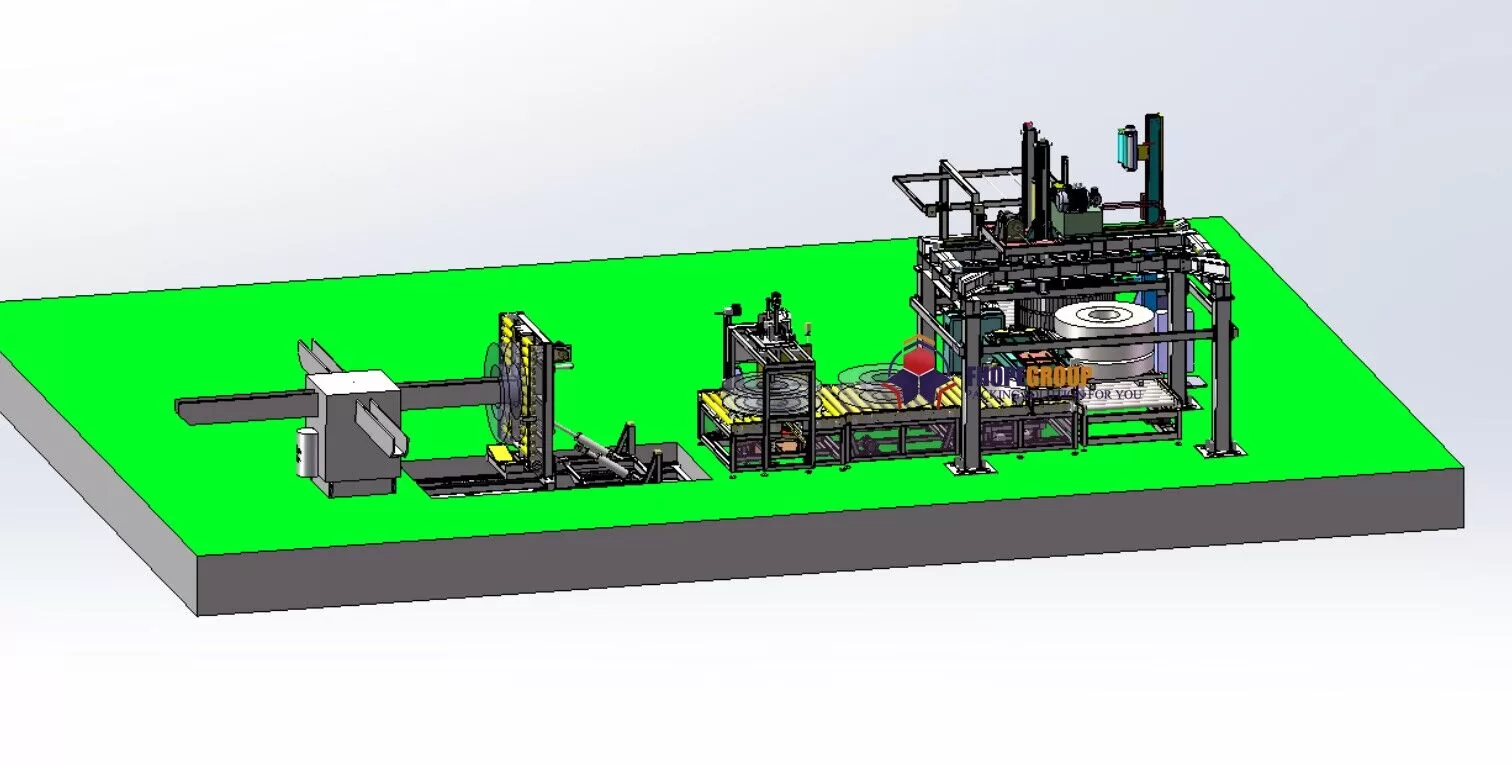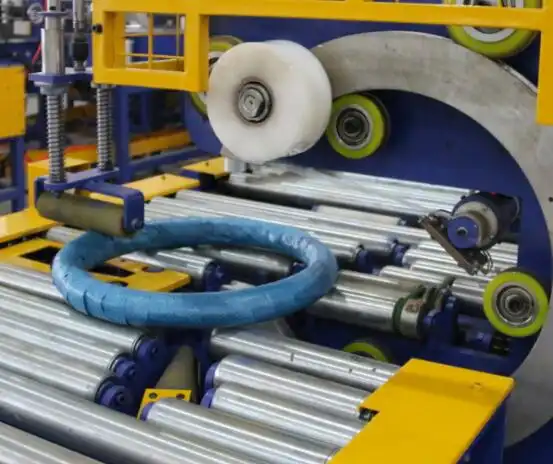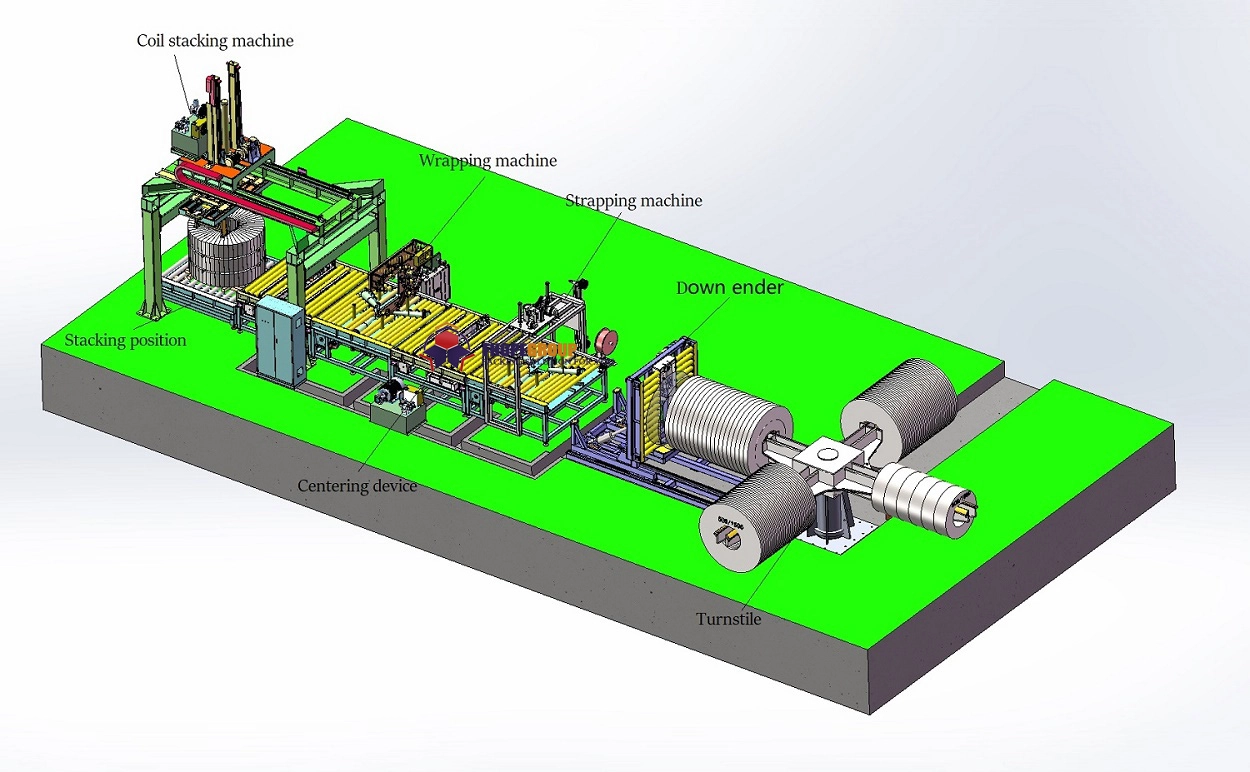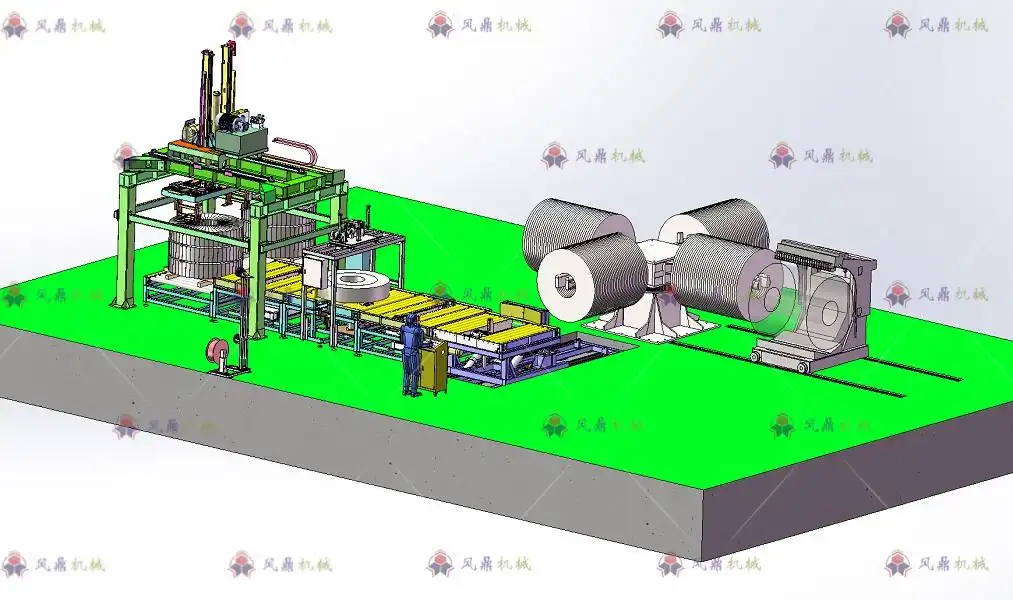Are you a plant manager or owner in Saudi Arabia's steel industry? You likely face the constant pressure of volatile energy costs. These costs can eat into your profit margins and make long-term financial planning difficult. I have seen many steel plants struggle with aging equipment that consumes too much power and requires frequent, costly maintenance. You might feel stuck, knowing that an upgrade is necessary but worried about the high initial investment and whether a new system will truly deliver the promised returns. This uncertainty can delay crucial decisions, while operational costs continue to climb.
The most effective way for Saudi steel plants to maximize ROI is by investing in a modern, energy-efficient steel coil packing line. These systems are specifically engineered with technologies like Variable Frequency Drives (VFDs), high-efficiency motors (IE3/IE4 standard), and intelligent automation. This combination significantly reduces electricity consumption per packed coil. It also minimizes material waste and lowers labor dependency, directly cutting operational costs and boosting your bottom line.
I've spent my entire career in this industry, first on the factory floor and now running my own company, SHJLPACK. I understand the challenges you face because I've lived them. The journey from engineer to factory owner taught me one key lesson: the right equipment is not an expense, it's a strategic investment in your plant's future. In a market as competitive as Saudi Arabia's, efficiency is not just a goal; it's essential for survival and growth. Let’s explore how upgrading your packing line can become a powerful driver of profitability for your plant. We will look at specific features, the role of automation, and what a true partnership with your equipment provider should look like.
How Can Modern Packing Lines Directly Tackle Rising Energy Costs in Saudi Arabia?
Does your plant's electricity bill feel like a moving target? One month it's manageable, the next it skyrockets, throwing off all your cost projections. This is a common problem I hear from plant owners in Saudi Arabia. They are dealing with older packing machinery that runs at full power regardless of the workload. This constant energy drain is like leaving a tap running. It's a waste of resources and a direct hit to your profitability. You know there must be a smarter way to operate, but finding a practical solution that fits your budget can be a challenge.
A modern steel coil packing line directly reduces energy costs by incorporating smart technologies that match power consumption to the immediate task. Key features include Variable Frequency Drives (VFDs) on motors, which adjust speed and torque as needed, instead of running at maximum output continuously. They also use premium efficiency motors (IE3 or higher) and regenerative braking systems that can recover and reuse energy during deceleration, leading to substantial and measurable savings on your electricity bill.

When I started my career, energy efficiency wasn't the top priority it is today. Machines were built to be robust, and power was relatively cheap. But times have changed, especially in regions focused on economic diversification like Saudi Arabia. Today, every kilowatt-hour saved is money earned. This is where modern engineering makes a tangible difference. Let's break down the specific components that contribute to these energy savings.
Variable Frequency Drives (VFDs)
The single biggest energy saver in a modern packing line is the VFD. Traditional motors are either on or off. They run at a fixed speed, consuming maximum power whenever they are active, even if the task requires less effort. A VFD acts like a dimmer switch for an electric motor. It precisely controls the motor's speed and torque. For example, a conveyor only needs full power when accelerating a heavy steel coil. Once the coil is moving, the power required to maintain its speed is much lower. A VFD automatically reduces the power output, saving significant energy. During my visits to various steel plants, I've seen VFD retrofits lead to motor energy savings of 20% to 50%, depending on the application.
High-Efficiency Motors
The motor itself is a critical part of the equation. Older motors, often rated as IE1 or IE2, can be inefficient, converting a large portion of electricity into wasted heat instead of mechanical work. Modern packing lines from SHJLPACK exclusively use IE3 (Premium Efficiency) or IE4 (Super Premium Efficiency) motors. These motors are designed with better materials and more precise construction to minimize electrical and thermal losses. The upgrade from an old IE1 motor to a new IE4 motor can provide an immediate efficiency gain of 5-10%. While that might seem small, when you have dozens of motors running across multiple shifts, the cumulative savings become substantial over the year.
Intelligent System Design and Power Management
Beyond individual components, the overall system design plays a crucial role. A well-designed line synchronizes all movements to eliminate unnecessary idling. Why should a wrapping station be powered up and ready if the next coil is still minutes away on the conveyor? An intelligent control system (PLC) manages the entire line as a single, cohesive unit. It powers down sections that are not in use and wakes them up just in time for the next operation. This "sleep mode" functionality, similar to what you see in modern computers, prevents the constant, low-level power drain that plagues older, unsynchronized systems.
| Technology | Traditional System (Problem) | Modern System (Solution) | Estimated Energy Saving |
|---|---|---|---|
| Motor Control | Fixed-speed starters; motor runs at 100% power | Variable Frequency Drives (VFDs); motor speed matches load | 20-50% |
| Motor Type | Standard Efficiency (IE1/IE2) | Premium/Super Premium (IE3/IE4) | 5-10% |
| System Operation | All components run continuously | PLC-based "sleep modes" for idle sections | 10-15% |
| Braking | Mechanical brakes; energy lost as heat | Regenerative braking; energy is recovered and reused | 5-10% |
Investing in a packing line with these features provides a direct and measurable reduction in your plant's energy consumption. This is not just a theoretical benefit; it's a concrete return on investment that shows up on your monthly utility bills.
What Key Features Define an "Energy-Efficient" Steel Coil Packing Machine?
You might be looking at new equipment specifications and see the term "energy-efficient" used everywhere. But what does it actually mean in the context of a steel coil packing machine? Many manufacturers make this claim, but the details are often vague. This can leave you feeling skeptical, wondering if the promised savings are real or just marketing fluff. You need to know the specific, tangible features that separate a genuinely efficient machine from an outdated power-hog, so you can make an informed investment decision.
An energy-efficient steel coil packing machine is defined by a combination of optimized mechanical design, advanced electrical components, and intelligent software. Key features include a direct-drive wrapping ring that eliminates power loss from belts and gears, the use of servo motors for precise, on-demand movements instead of constantly running hydraulics, and lightweight yet durable construction materials for moving parts, which reduces the motor load required for acceleration and deceleration.

When we design a packing line at SHJLPACK, our philosophy is "efficiency by design." This means we don't just add a few efficient components to an old framework. We rethink the entire process to minimize energy use at every single step. From the way a coil is loaded onto the machine to the final ejection, every movement is analyzed and optimized. Let’s dive deeper into the specific engineering choices that make this possible.
Rethinking the Drive System
The heart of any wrapping machine is the system that rotates the wrapping material around the coil. For years, the standard was a motor connected to the wrapping ring via a series of belts, chains, or gears.
- Problem: Each of these transmission points introduces friction and energy loss. Belts can slip, chains require lubrication and adjustment, and gearboxes lose a percentage of power through heat. I've seen older machines where up to 15% of the motor's power is lost before it even reaches the wrapping ring.
- Solution: We use a direct-drive system. In this design, a high-torque ring motor is integrated directly into the wrapping ring assembly. This eliminates the need for intermediate transmission components. The power transfer is nearly 100% efficient. This design is also quieter, requires significantly less maintenance, and provides smoother, more consistent wrapping.
Servo Motors vs. Hydraulics for Auxiliary Movements
A packing line involves more than just wrapping. Coils need to be lifted, centered, and moved by various rollers and pushers. Traditionally, these movements were powered by a central hydraulic power unit.
- Problem: A hydraulic pump often runs continuously to maintain pressure in the system, even when no movement is occurring. This is a massive source of standby power consumption. Hydraulic systems are also prone to leaks and require regular fluid changes and maintenance.
- Solution: We replace hydraulic systems with high-precision electric servo motors for these auxiliary functions. A servo motor uses energy only when it is performing a task. Its power consumption is directly proportional to the work it's doing. When it's not moving, its energy draw is near zero. This on-demand power usage drastically cuts down the machine's overall idle power consumption.
Smart Material Usage
Energy efficiency isn't just about electricity. It's also about the energy embedded in your consumables, like wrapping film. Wasting packing material is wasting money and resources.
- Problem: Older machines often have a fixed stretch ratio for the packing film. This means they might over-stretch and weaken the film on small coils or under-stretch and waste film on larger coils.
- Solution: Our machines feature a powered pre-stretch system with adjustable tension control. The system can achieve a pre-stretch ratio of up to 300%. This means one meter of film is stretched to become four meters before it's applied to the coil. The tension is electronically controlled and can be adjusted for different coil sizes and weights, ensuring optimal film usage every time. This reduces your material costs and the labor required to change film rolls.
| Feature | Inefficient (Old) Design | Energy-Efficient (New) Design | Primary Benefit |
|---|---|---|---|
| Wrapping Ring Drive | Motor with belts, chains, or gearbox | Integrated direct-drive ring motor | Eliminates transmission power loss |
| Auxiliary Movements | Central hydraulic power unit | Individual electric servo motors | Eliminates idle power consumption |
| Conveyor System | Constantly running roller beds | Zone-based, sensor-activated conveyors | Powers only the necessary sections |
| Material Stretch | Fixed or no pre-stretch | Powered pre-stretch (up to 300%) | Reduces consumable material waste |
By focusing on these core engineering features, you can confidently identify a machine that will deliver real, long-term savings in both energy and materials.
How Does Automation in Packing Lines Contribute to Overall Plant ROI?
As a steel mill owner, you are constantly evaluating every part of your operation for cost savings and efficiency gains. You might see the packing area as a necessary but high-cost center, heavily reliant on manual labor. This dependence can lead to inconsistencies in package quality, safety risks for your workers, and production bottlenecks that limit your plant's overall output. You're looking for a solution that not only cuts costs but also transforms your packing line into a reliable, high-performing asset.
Automation in a steel coil packing line contributes to a higher ROI by fundamentally reducing operational expenditures and increasing throughput. It achieves this by minimizing the need for manual labor, drastically lowering the chance of human error, ensuring consistent and optimal use of packing materials, and operating at a faster, more predictable pace than manual or semi-automatic processes. This leads to lower labor costs, less material waste, and higher overall production capacity.

I remember walking through a client's plant years ago. They had a team of six people working in their packing bay. It was a chaotic, labor-intensive process. Coils were waiting, people were rushing, and the final package quality varied from shift to shift. After we installed a fully automated line, the same work was done by just one supervisor. The transformation was incredible. The ROI wasn't just in labor savings; it was in the newfound consistency, safety, and speed of their entire end-of-line process. Let's break down exactly where these ROI gains come from.
Drastic Reduction in Labor Costs
This is the most direct and easily calculated return. A manual packing process requires multiple operators per shift for tasks like applying wrapping material, placing corner protectors, strapping the coil, and printing and applying labels.
- Before Automation: A typical line might need 3-5 operators per shift. For a plant running three shifts, this could be up to 15 employees dedicated just to packing. This comes with salaries, benefits, training, and management overhead.
- After Automation: A fully automated line can perform all these tasks with zero direct manual intervention. The process is managed by a single supervisor who oversees the system and handles any exceptions. This can reduce your packing-related labor costs by 80% or more. The ROI calculation is simple: (Annual cost of eliminated labor) / (Cost of automation investment). In my experience, the payback period from labor savings alone can often be less than two years.
Improved Material Efficiency and Consistency
Human operators, no matter how well-trained, will have variations in how they perform tasks. This directly impacts material consumption.
- Problem: An operator might apply too much stretch film on one coil and not enough on the next. Straps might be placed inconsistently. This leads to wasted material and, more importantly, packages that may not provide adequate protection during transport, leading to customer complaints and claims.
- Solution: An automated system is ruthlessly consistent. The powered pre-stretch unit applies the exact, programmed amount of film with the optimal tension every time. The strapping machine places straps at precise, pre-defined locations with the correct tension. This optimized material usage can reduce consumable costs by 15-25% and ensures every coil is packed to the same high standard, protecting your product and your reputation.
Increased Throughput and Reduced Bottlenecks
Your production line is only as fast as its slowest point. In many steel plants, the packing station is a major bottleneck.
- Problem: Manual packing is slow and its pace is unpredictable. It can't keep up with the output from a modern slitting or recoiling line. This forces you to either slow down your entire production process or deal with a growing backlog of unpacked coils, which consumes valuable floor space.
- Solution: An automated packing line is designed for high throughput. It can be synchronized with the speed of your production line. Cycle times are predictable and fast. A typical automated line can fully wrap, strap, and label a coil in just a few minutes, a fraction of the time it would take a manual team. By eliminating this bottleneck, you unlock the true production capacity of your entire plant.
| ROI Contribution Area | Semi-Automatic/Manual Process | Fully Automated Process | Key Impact |
|---|---|---|---|
| Labor | 3-5 operators per shift | 1 supervisor per shift | Reduces direct labor costs by >80% |
| Material Usage | Inconsistent, high waste | Optimized, consistent, minimal waste | Cuts consumable costs by 15-25% |
| Throughput | Slow, unpredictable, bottleneck | Fast, consistent, synchronized with production | Increases overall plant output |
| Safety & Quality | Higher risk of injury, variable quality | Minimal human intervention, uniform high quality | Reduces accidents and customer claims |
Investing in automation is not just about replacing people with machines. It's about re-engineering your process for maximum efficiency, quality, and output, delivering a powerful and multifaceted return on your investment.
What Is the Role of a Supplier as a Strategic Partner in Digital Transformation?
You are leading your steel plant into the future, and you know that "Industry 4.0" and "digital transformation" are more than just buzzwords. You want to implement these concepts to make your operations smarter and more data-driven. However, when you talk to equipment suppliers, many of them just want to sell you a machine. They don't understand your bigger picture or your goals for a fully connected, digitized plant. This leaves you feeling like you have to piece the solution together yourself, a daunting task that risks incompatibility and failure.
A true strategic partner's role extends far beyond just supplying equipment. In the context of digital transformation, a partner like SHJLPACK actively helps you integrate the new packing line into your plant's digital ecosystem. This involves providing machines with open communication protocols, offering full access to sensor data, and collaborating with your IT and operations teams to ensure the packing line can seamlessly connect to your Manufacturing Execution System (MES) and Enterprise Resource Planning (ERP) systems.

I founded SHJLPACK on the principle of being a total solution provider. This philosophy came from my own frustrations as an engineer. I saw factories buy great machines that ended up as "digital islands" because the supplier didn't care about integration. They delivered the machine and disappeared. That's not a partnership. A partnership means we are on this journey with you. Our success is tied to your success in creating a truly smart factory. Let's look at what this partnership looks like in practice.
Stage 1: Collaborative Design and Consultation
The partnership begins long before a single bolt is turned. A strategic partner doesn't start by showing you a catalog. We start by listening.
- Supplier Mentality: "Here is our standard model. It costs X."
- Partner Mentality: "Let's discuss your current data infrastructure. What MES are you using? What are your key performance indicators (KPIs) for this production stage? What data do you need from the packing line to make better decisions?"
We work with your team to understand your digital roadmap. We then design the packing line's control system to be compatible from the ground up. This means choosing the right PLC and HMI, and ensuring it supports common industrial communication protocols like OPC UA, PROFINET, or EtherNet/IP. This pre-planning prevents major headaches during commissioning.
Stage 2: Data Accessibility and Transparency
A "black box" machine is useless in a smart factory. You need access to the data it generates.
- Supplier Mentality: "The machine runs, that's what matters. The data is proprietary."
- Partner Mentality: "Here is a full list of data points our machine generates. Let's decide which ones are most valuable for you."
A modern packing line is loaded with sensors: motor temperature, power consumption, film tension, cycle counts, fault codes, and more. A strategic partner provides you with an open and well-documented data map. This allows your own systems to pull this information directly from the machine's PLC. You can then use this data to build dashboards for real-time production monitoring, track Overall Equipment Effectiveness (OEE), and feed data into predictive maintenance algorithms.
Stage 3: Integration Support and Long-Term Evolution
The day the machine is installed is the beginning of the relationship, not the end. As your digital strategy evolves, your equipment needs to evolve with it.
- Supplier Mentality: "Our job is done. Call us if it breaks."
- Partner Mentality: "Our team is available to work with your systems integrator to connect the machine to your MES. As you develop new analytics, we can help you explore how to get more data from the machine."
This means providing technical support during the integration phase and being a resource for future upgrades. For example, you might decide to implement a predictive maintenance program a year after installation. A strategic partner can help you identify the key sensor data for this purpose and assist in setting up the data streams.
| Aspect of Partnership | Standard Supplier | Strategic Partner (SHJLPACK) | Impact on Your Digital Transformation |
|---|---|---|---|
| Initial Phase | Sells a standard machine | Consults on your digital ecosystem and goals | Ensures compatibility from day one |
| Data Policy | Treats data as proprietary or provides limited access | Provides open, documented access to all sensor data | Enables real-time monitoring, OEE, and analytics |
| Integration | Leaves MES/ERP connection to the client | Actively supports the integration process | Reduces project time, cost, and complexity |
| Long-Term | Offers only break-fix support | Collaborates on future upgrades and evolving data needs | Future-proofs your investment |
Choosing a supplier is a simple transaction. Choosing a strategic partner is an investment in your plant's digital future. It ensures your new equipment becomes an active, contributing node in your smart factory network, not an isolated piece of metal.

Conclusion
Investing in an energy-efficient, automated packing line is a strategic move to boost ROI. It directly cuts energy and labor costs, increases throughput, and supports your plant's digital transformation goals.





